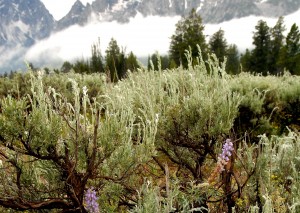At one time I considered sagebrush a sort of useless weed, a wasteland by-product, but since have become fascinated by this important and productive plant and its useful place in a healthy ecosystem.
On a recent trip to central Idaho, we drove for miles on roads winding through sagebrush meadows, a terrain often called prairie or steppe. An attractive roadside sign titled “Wildlife in the Sagebrush Meadow” piqued my interest and when we returned home I delved deeper into the marvels of sagebrush.
Sagebrush comes in a variety of sizes and is a coarse, many-branched, silvery-grey shrub with yellow flowers and silvery-grey foliage. Sagebrush thrives because a long taproot draws water from deep underground. In the meantime, its shallow roots collect scarce rainwater near the surface. Rub a silver-green leaf between your fingers to smell the sagebrush’s distinctive pungent odor, similar to terpentine. Once sagebrush has passed the seedling stage, it can reach ages of more than 100 years. It can grow 2 to 12 feet tall.
Although often too dry to support trees, sagebrush prairies support nest sites and provide cover from wind and predators, harbor food for insect-eating wildlife and provide the main winter food for sage grouse and pronghorn antelope.
Many species of animals call sagebrush “home,” including hundreds of birds, 70 mammals, 23 reptiles and amphibians, 72 spiders and more than 100 insects. Interestingly, pronghorn antelope are the only large herbivores who browse on sagebrush extensively. Some birds, such as sage grouse live nowhere else. These many species are important to the sagebrush ecosystem itself, providing crucial services such as dispersing seeds and preying on insects and rodents. Idaho grows ten different kinds of sagebrush and all provide unique habitat for wildlife prairie dwellers.
In addition, plants and grasses that grow under the sagebrush provide nesting materials and protein-rich insects for birds. Sage grouse depend on mature shrubs for shelter in winter and camouflage nesting sites under the protective canopy of leaves in spring.
Sagebrush habitats across the West have been greatly altered by a century of settlement, livestock grazing, agriculture and weed invasion. With care, these valuable sagebrush prairies can be managed and rejuvenated to enrich habitat for the myriad of wildlife that depend on it.
Here are a few steps that can be taken to preserve sagebrush:
– Eliminate invasive plants, such as cheatgrass that chokes out native sagebrush. Other invasive plants include Russian knapweed, jointed goatgrass, and musk thistle.
– Off-road vehicles, primarily all-terrain vehicles (ATVs) can damage biological soil structure. Their wheels can carry and transport seeds of invasive plants. Regulated areas should be off-limits to such vehicles. In addition ATVs create noise and disturbance to the animals that the sagebrush prairie supports.
– Limit the conversion of sagebrush land to cropland or pasture. Reduce the number of stock allowed to graze the small plants and grasses in sagebrush prairies, and also eliminate grazing May through mid-July to avoid trampling of ground nests and nestlings.
Sagebrush is a rugged plant, but is suffering from human interference. This essential shrub now needs human intervention to protect its vital existence in a healthy ecosystem.
Note: To leave a comment, click on “Leave a Reply.”


